Cardinal Michael Czerny has said that Pope Leo XIV is “in perfect continuity” with Pope Francis, describing the new pontiff as one who is “implementing processes that Francis set in motion.”
“The transition from one Holy Father to another is not primarily a transition in policies,” the Canadian Jesuit told AP News on 7 November.
“A change in governments from one party to the next can signal a break, but here it would be a mistake to look for that. The stylistic differences are in the person, not in the teaching.”
Cardinal Czerny, who has served as Prefect of the Dicastery for Promoting Integral Human Development since 2022, has been a close adviser to both popes. His remarks came as speculation continues over how Leo XIV will handle and interpret the reforms of his predecessor, particularly whether he will overhaul the Curia and the synodal process.
In terms of style, Pope Leo has shown a preference for traditional papal appearances, often wearing the red mozzetta cape and embroidered stole for ceremonial events, and adhering strictly to his prepared texts rather than departing into ad-lib remarks. His disciplined liturgical observance contrasts with Francis’s more informal approach, yet his priorities appear unchanged.
Leo XIV’s early months have also been marked by an effort to reassure parts of the Church that had grown uneasy under Francis. For the first time since 2021, the Traditional Latin Mass was permitted to be celebrated in St Peter’s. Some early appointments, such as Cardinal Baldassare Reina replacing Archbishop Vincenzo Paglia as Grand Chancellor of the Pontifical John Paul II Theological Institute for Marriage and Family Sciences, and Cardinal Robert Sarah being appointed as Special Envoy to preside over the liturgical celebrations for the 400th anniversary of the apparitions of Saint Anne to the Breton farmer Yvon Nicolazic in France, also signalled hope for conservatives.
But it appears the so-called honeymoon period is over. The recent release of a Marian document addressing the question of Mary as co-redemptrix has renewed scrutiny of the new pontificate, with some suggesting that the same currents of commentary and contention that accompanied Francis’s papacy are already shaping the narrative around Leo XIV.
Born in Brno, Czechoslovakia, in 1946, Cardinal Czerny fled Communist persecution with his family and settled in Canada. A member of the Society of Jesus since 1964, he was ordained in 1973 and went on to found the Jesuit Centre for Social Faith and Justice in Toronto.
He later worked in Latin America, taking up the role of Director of the Institute for Human Rights at the University of Central America after the murder of six Jesuits there. From 2002 he directed the African Jesuit AIDS Network, coordinating pastoral and medical outreach across 30 countries. After joining the Roman Curia, he was made a cardinal by Pope Francis in 2019 and became one of the Holy See’s most active voices on migration, social justice, and humanitarian issues.
(Photo by TIZIANA FABI/AFP via Getty Images)
















